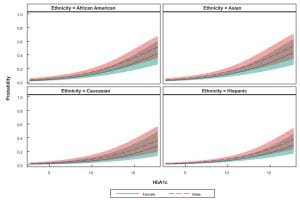BLOOMINGTON, IN — A group of researchers at Indiana University School of Optometry found individuals are at different risks for retinal damage from diabetes, with certain ethnic groups and males being at a greater risk.

“Complications to the retinas of diabetic patients are more likely in some groups, such as African Americans or Asians, even when economic and geographic factors are similar,” says IU School of Optometry Distinguished Professor Ann E. Elsner, PhD, who was the lead researcher of the study and worked with IUSO graduate student Vamsi Parimi, MSc, and IUSO Senior Scientist Thomas J. Gast, MD, PhD, to analyze the data.
Diabetes is a widespread disease that causes damage to the eyes. The retina, which is the part of the eye that captures light and is necessary to initiate vision, is especially vulnerable. The research findings demonstrated that individuals in some ethnic groups were more likely to have damaged retinas, even when all the individuals lacked medical insurance.
“We also documented that the diabetes was severely out of control for some individuals, and these were the ones most likely to have damaged retinas,” explains Dr. Elsner. “Males in some of the groups were particularly likely to have damaged retinas.”
Patients with diabetes have varying likelihood of developing retinal damage, and some need closer monitoring than others. Many individuals have barriers to eye care that can interfere with receiving the prompt diagnosis and treatment that can save vision.
The study looked at patients from several ethnic groups, all of whom had economic barriers to eye care. The sample of

underserved patients from the same clinics had blood glucose levels much higher than is usually reported in clinical trials, which was related to the higher rates of retinal damage. Even though these extreme values of blood glucose were commonly present, the analysis showed that some ethnic groups were especially likely to have eye disease from diabetes, with African American males and Asians having higher rates of retinal damage than Caucasians.
The research found diabetic patients who are African American, particularly males, as well as Asian diabetic patients, should be followed closely by eye care professionals. Any diabetic patient who cannot bring their blood glucose to normal limits should also be followed carefully for eye and other complications. Many patients have economic or other barriers to health care. The consequences of lack of eye care are emphasized in this study.
“It is important to decrease all barriers to eye care,” says Dr. Elsner. “It is also important to provide more help, such as lowering the price of insulin, to diabetic patients to allow them to maintain good control of their blood glucose.”
The National Eye Institute funded the study for more than $2 million. The data were collected by Alameda Health in Alameda County, CA, by UC Berkeley School of Optometry staff Taras Litvin, OD, PhD; Glen Ozawa, OD; and Jorge Cuadros, OD, PhD.

The full details of this study will be published in November as “Clinically Significant Macular Edema in an Underserved Population: Association with Demographic Factors and HbA1c” in Optometry and Vision Science, a journal of the American Academy of Optometry.
About Indiana University School of Optometry
The Indiana University School of Optometry prepares its students for careers in optometry, the ophthalmic industry, and vision science through teaching, research, and service. The school is home to the most comprehensive and advanced eye health education, research, and patient care available with an emphasis on outreach to the most vulnerable populations. For more information on the IU School of Optometry, visit optometry.iu.edu.
Leave a Reply